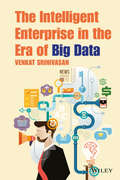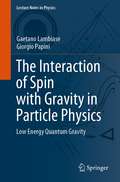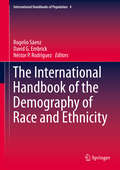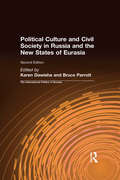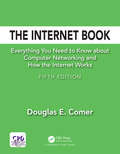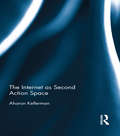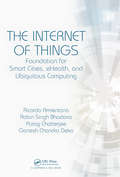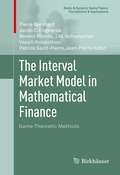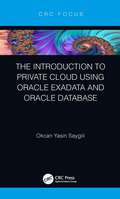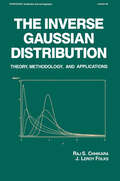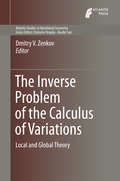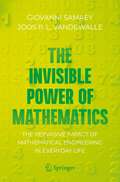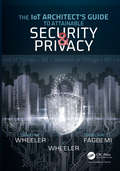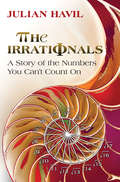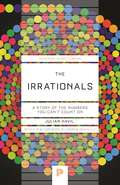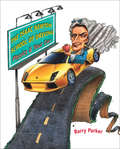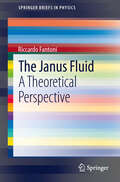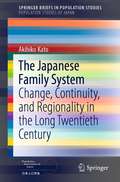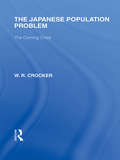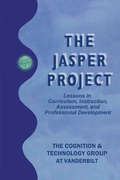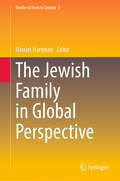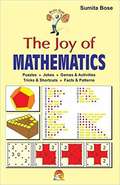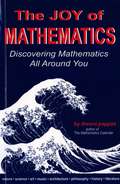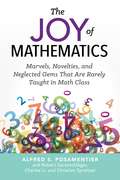- Table View
- List View
The Intelligent Enterprise in the Era of Big Data
by Venkat SrinivasanAn innovative guide to the organization and function of enterprises in the technological age In the era of big data and automation, this book presents a cutting-edge approach in how enterprises should organize and function. Striking a practical balance between theory and practice, The Intelligent Enterprise in the Era of Big Data presents an enterprise architecture that embodies the power of the emerging technology environment. Beginning with an introduction to the key challenges that enterprises face, the book systematically outlines a modern enterprise architecture through a detailed discussion of the inseparable elements of such an architecture: efficiency, flexibility, and intelligence. This architecture enables rapid responses to market needs by facilitating intelligent, flexible automation of enterprise business processes and sensing important developments in internal and external environments in near real time. Illustrating all of these elements in an integrated fashion, The Intelligent Enterprise in the Era of Big Data also features: A detailed discussion on issues of time-to-market and flexibility with respect to enterprise application technology Novel analyses illustrated through extensive real-world case studies to help readers better understand the applicability of the architecture and concepts Practical approaches for designing and building intelligent enterprises An appendix that presents various approaches to text analysis with real-world business implications The Intelligent Enterprise in the Era of Big Data is an appropriate reference for business executives, information technology professionals, data scientists, and management consultants.
The Interaction of Spin with Gravity in Particle Physics: Low Energy Quantum Gravity (Lecture Notes in Physics #993)
by Gaetano Lambiase Giorgio PapiniThis book seeks to present a new way of thinking about the interaction of gravitational fields with quantum systems. Despite the massive amounts of research and experimentation, the myriad meetings, seminars and conferences, all of the articles, treatises and books, and the seemingly endless theorization, quantization and just plain speculation that have been engaged in regarding our evolving understanding of the quantum world, that world remains an enigma, even to the experts. The usefulness of general relativity in this regard has proven to be imperfect at best, but there is a new approach. We do not simply have to accept the limitations of Einstein's most celebrated theorem in regard to quantum theory; we can also embrace them, and thereby utilize them, to reveal new facts about the behavior of quantum systems within inertial and gravitational fields, and therefore about the very structure of space–time at the quantum level. By taking existing knowledge of the essential functionality of spin (along with the careful identification of the omnipresent inertial effects) and applying it to the quantum world, the book gives the reader a much clearer picture of the difference between the classical and quantum behaviors of a particle, shows that Einstein's ideas may not be as incompatible within this realm as many have come to believe, sparks new revelations of the way in which gravity affects quantum systems and brings a new level of efficiency—quantum efficiency, if you will—to the study of gravitational theory.
The International Handbook of the Demography of Race and Ethnicity
by Rogelio Sáenz David G. Embrick Néstor P. RodríguezExamining key countries in every region of world, this handbook presents population profiles and analyses concerning racial/ethnic disparities and changing intergroup relations. Inside, prominent scholars from various parts of the world and disciplines address the links between stratification, demography, and conflict across the globe. Organized by region/continent, coverage for each profiled country includes demographic information; a historical overview that addresses past racial/ethnic conflict; identification of the most salient demographic trends and issues that the country faces; theoretical issues related to the linkages between stratification, demography, and conflict; methodological issues including quality of data and cutting-edge methods to better understand the issue at hand; and details on the possible future of the existing trends and issues with particular emphasis on public policy and human rights. This handbook will help readers to better understand the commonalities and differences that exist globally in the interplay between stratification, demography, and conflict. In addition, it also provides an excellent inventory of theoretical perspectives and methodological approaches that are needed to better comprehend this issue. This handbook will appeal to students, researchers, and policy analysts in the areas of race and ethnic relations, demography, inequality, international sociology, international relations, foreign studies, social geography, and social development.
The International Politics of Eurasia: Vol 7: Political Culture and Civil Society in Russia and the New States of Eurasia
by Karen Dawisha Bruce ParrottFirst Published in 1998. Routledge is an imprint of Taylor & Francis, an Informa company.
The Internet Book: Everything You Need to Know about Computer Networking and How the Internet Works
by Douglas E. ComerThe Internet Book, Fifth Edition explains how computers communicate, what the Internet is, how the Internet works, and what services the Internet offers. It is designed for readers who do not have a strong technical background — early chapters clearly explain the terminology and concepts needed to understand all the services. It helps the reader to understand the technology behind the Internet, appreciate how the Internet can be used, and discover why people find it so exciting. In addition, it explains the origins of the Internet and shows the reader how rapidly it has grown. It also provides information on how to avoid scams and exaggerated marketing claims. <P><P>The first section of the book introduces communication system concepts and terminology. The second section reviews the history of the Internet and its incredible growth. It documents the rate at which the digital revolution occurred, and provides background that will help readers appreciate the significance of the underlying design. The third section describes basic Internet technology and capabilities. It examines how Internet hardware is organized and how software provides communication. This section provides the foundation for later chapters, and will help readers ask good questions and make better decisions when salespeople offer Internet products and services. The final section describes application services currently available on the Internet. For each service, the book explains both what the service offers and how the service works. <P><P>About the Author <P><P>Dr. Douglas Comer is a Distinguished Professor at Purdue University in the departments of Computer Science and Electrical and Computer Engineering. He has created and enjoys teaching undergraduate and graduate courses on computer networks and Internets, operating systems, computer architecture, and computer software. One of the researchers who contributed to the Internet as it was being formed in the late 1970s and 1980s, he has served as a member of the Internet Architecture Board, the group responsible for guiding the Internet’s development. Prof. Comer is an internationally recognized expert on computer networking, the TCP/IP protocols, and the Internet, who presents lectures to a wide range of audiences. In addition to research articles, he has written a series of textbooks that describe the technical details of the Internet. Prof. Comer’s books have been translated into many languages, and are used in industry as well as computer science, engineering, and business departments around the world. Prof. Comer joined the Internet project in the late 1970s, and has had a high-speed Internet connection to his home since 1981. He wrote this book as a response to everyone who has asked him for an explanation of the Internet that is both technically correct and easily understood by anyone. An Internet enthusiast, Comer displays INTRNET on the license plate of his car.
The Internet as Second Action Space
by Aharon KellermanOne of the most significant and important advancements in information and communication technology over the past 20 years is the introduction and expansion of the Internet. Now almost universally available, the Internet brings us email, global voice and video communications, research repositories, reference libraries, and almost unlimited opportunities for daily activities. Bridging geographical distances in unprecedented ways, the Internet has impacted all aspects of our daily lives – from facilitating the running of businesses, the attainment of services and keeping in touch with friends and family. Accessible at any time and for many of us from our mobile phones, the Internet has opened up a world of knowledge and communication platforms that we cannot now imagine living without. This book explores the concept that the Internet has become a second action space for individuals. Coexisting with traditional and "obvious" real space, the Internet serves as a novel spatial platform and action space to its subscribers all over the world. Kellerman expertly discusses this notion and examines the practical integration of cyberspace with real space. Part I examines the Internet as a platform for action and presents its relations with physical space concerning a range of uses and applications which were traditionally performed in physical space only. It discusses the idea that the Internet has become a second space and explores theoretical perspectives surrounding this notion. The Internet has undeniably made humankind more efficient and connected. Part II explores the Internet as an action space for human life, considering basic human needs, curiosity, identity and social relations. It further considers instances whereby use and application of the Internet cannot be fully performed in real space, mainly regarding people’s presentation of identity. Part III explores daily actions over the Internet, such as work, shopping, banking and social interactions. Kellerman also briefly touches on the darker aspects that the expansion of the Internet has made possible – including its role in fraud and other crimes. The concluding chapter discusses people living across the two spaces and identifies potential future developments. The Internet as Second Actions Space will appeal to students across the social sciences, in particular those studying Geography, Sociology, Media Studies, Internet Studies, Business and related disciplines.
The Internet of Things: Foundation for Smart Cities, eHealth, and Ubiquitous Computing (Advances In Information Security, Privacy, And Ethics Ser.)
by Ricardo Armentano, Robin Singh Bhadoria, Parag Chatterjee and Ganesh Chandra DekaThis book provides a dual perspective on the Internet of Things and ubiquitous computing, along with their applications in healthcare and smart cities. It also covers other interdisciplinary aspects of the Internet of Things like big data, embedded Systems and wireless Sensor Networks. Detailed coverage of the underlying architecture, framework, and state-of the art methodologies form the core of the book.
The Interval Market Model in Mathematical Finance
by Pierre Bernhard J. M. Schumacher Patrick Saint-Pierre Jean-Pierre Aubin Vassili Kolokoltsov Berend Roorda Jacob C. EngwerdaToward the late 1990s, several research groups independently began developing new, related theories in mathematical finance. These theories did away with the standard stochastic geometric diffusion "Samuelson" market model (also known as the Black-Scholes model because it is used in that most famous theory), instead opting for models that allowed minimax approaches to complement or replace stochastic methods. Among the most fruitful models were those utilizing game-theoretic tools and the so-called interval market model. Over time, these models have slowly but steadily gained influence in the financial community, providing a useful alternative to classical methods. A self-contained monograph, The Interval Market Model in Mathematical Finance: Game-Theoretic Methods assembles some of the most important results, old and new, in this area of research. Written by seven of the most prominent pioneers of the interval market model and game-theoretic finance, the work provides a detailed account of several closely related modeling techniques for an array of problems in mathematical economics. The book is divided into five parts, which successively address topics including: · probability-free Black-Scholes theory; · fair-price interval of an option; · representation formulas and fast algorithms for option pricing; · rainbow options; · tychastic approach of mathematical finance based upon viability theory. This book provides a welcome addition to the literature, complementing myriad titles on the market that take a classical approach to mathematical finance. It is a worthwhile resource for researchers in applied mathematics and quantitative finance, and has also been written in a manner accessible to financially-inclined readers with a limited technical background.
The Introduction to Private Cloud using Oracle Exadata and Oracle Database
by Okcan Yasin SaygiliPrivate clouds allow for managing multiple databases under one roof, avoiding unnecessary resource management. Private cloud solutions can be applied in sectors such as healthcare, retail, and software. The Introduction to Private Cloud using Oracle Exadata and Oracle Database will explore the general architecture of private cloud databases with a focus on Oracle’s Exadata database machine. The book describes the private cloud using fundamental-level Exadata and database. Exadata has been Oracle’s pioneer product for almost a decade. In the last few years, Oracle has positioned Exadata for customers to consume as a cloud service. This book will provide a timely introduction to Exadata for current and potential Oracle customers and other IT professionals.
The Inverse Gaussian Distribution: Theory: Methodology, and Applications (Statistics: A Series of Textbooks and Monographs)
by Raj Chhikara J. Leroy FolksThis monograph is a compilation of research on the inverse Gaussian distribution. It emphasizes the presentation of the statistical properties, methods, and applications of the two-parameter inverse Gaussian family of distribution. It is useful to statisticians and users of statistical distribution.
The Inverse Problem of the Calculus of Variations
by Dmitry V. ZenkovThe aim of the present book is to give a systematic treatment of the inverse problem of the calculus of variations, i. e. how to recognize whether a system of differential equations can be treated as a system for extremals of a variational functional (the Euler-Lagrange equations), using contemporary geometric methods. Selected applications in geometry, physics, optimal control, and general relativity are also considered. The book includes the following chapters: - Helmholtz conditions and the method of controlled Lagrangians (Bloch, Krupka, Zenkov) - The Sonin-Douglas's problem (Krupka) - Inverse variational problem and symmetry in action: The Ostrogradskyj relativistic third order dynamics (Matsyuk. ) - Source forms and their variational completion (Voicu) - First-order variational sequences and the inverse problem of the calculus of variations (Urban, Volna) - The inverse problem of the calculus of variations on Grassmann fibrations (Urban).
The Invisible Power of Mathematics: The Pervasive Impact of Mathematical Engineering in Everyday Life (Copernicus Books)
by Giovanni Samaey Joos P. VandewalleHow does homebanking work? How are board games developed? How reliable can wind energy get? How do we discover forged paintings? Do smart girls stay single? How dangerous can a bioterrorist get? In all these questions (and many others), mathematics plays a crucial role in the search for an answer.This book tells the story behind twenty of these questions. This is explicitly not a mathematics book, but a book about the crucial role that mathematics plays in devising the creative solutions the world needs. The questions are divided into three categories: home, garden and kitchen mathematics; mathematics for the workplace; and mathematics for tomorrow's society. The themes illustrate not only the incredibly broad applicability of mathematics in the world around us, but also the great diversity of useful mathematical techniques.
The IoT Architect's Guide to Attainable Security and Privacy
by Damilare D. Fagbemi David M Wheeler JC WheelerThis book describes how to architect and design Internet of Things (loT) solutions that provide end-to-end security and privacy at scale. It is unique in its detailed coverage of threat analysis, protocol analysis, secure design principles, intelligent loT's impact on privacy, and the effect of usability on security. The book also unveils the impact of digital currency and the dark web on the loT-security economy. It's both informative and entertaining. "Filled with practical and relevant examples based on years of experience ... with lively discussions and storytelling related to loT security design flaws and architectural issues."— Dr. James F. Ransome, Senior Director of Security Development Lifecycle (SOL) Engineering, Intel 'There is an absolute treasure trove of information within this book that will benefit anyone, not just the engineering community. This book has earned a permanent spot on my office bookshelf."— Erv Comer, Fellow of Engineering, Office of Chief Architect Zebra Technologies 'The importance of this work goes well beyond the engineer and architect. The IoT Architect's Guide to Attainable Security & Privacy is a crucial resource for every executive who delivers connected products to the market or uses connected products to run their business."— Kurt Lee, VP Sales and Strategic Alliances at PWNIE Express "If we collectively fail to follow the advice described here regarding loT security and Privacy, we will continue to add to our mounting pile of exploitable computing devices. The attackers are having a field day. Read this book, now."— Brook S.E. Schoenfield, Director of Advisory Services at IOActive, previously Master Security Architect at McAfee, and author of Securing Systems
The Irrationals: A Story of the Numbers You Can't Count On
by Julian HavilThe ancient Greeks discovered them, but it wasn't until the nineteenth century that irrational numbers were properly understood and rigorously defined, and even today not all their mysteries have been revealed. InThe Irrationals, the first popular and comprehensive book on the subject, Julian Havil tells the story of irrational numbers and the mathematicians who have tackled their challenges, from antiquity to the twenty-first century. Along the way, he explains why irrational numbers are surprisingly difficult to define--and why so many questions still surround them. That definition seems so simple: they are numbers that cannot be expressed as a ratio of two integers, or that have decimal expansions that are neither infinite nor recurring. But, asThe Irrationalsshows, these are the real "complex" numbers, and they have an equally complex and intriguing history, from Euclid's famous proof that the square root of 2 is irrational to Roger Apry's proof of the irrationality of a number called Zeta(3), one of the greatest results of the twentieth century. In between, Havil explains other important results, such as the irrationality of e and pi. He also discusses the distinction between "ordinary" irrationals and transcendentals, as well as the appealing question of whether the decimal expansion of irrationals is "random". Fascinating and illuminating, this is a book for everyone who loves math and the history behind it.
The Irrationals: A Story of the Numbers You Can't Count On (Princeton Science Library #135)
by Julian HavilAn entertaining and enlightening history of irrational numbers, from ancient Greece to the twenty-first centuryThe ancient Greeks discovered them, but it wasn't until the nineteenth century that irrational numbers were properly understood and rigorously defined, and even today not all their mysteries have been revealed. In The Irrationals, the first popular and comprehensive book on the subject, Julian Havil tells the story of irrational numbers and the mathematicians who have tackled their challenges, from antiquity to the twenty-first century. Along the way, he explains why irrational numbers are surprisingly difficult to define—and why so many questions still surround them. Fascinating and illuminating, this is a book for everyone who loves math and the history behind it.
The Isaac Newton School of Driving: Physics and Your Car
by Barry ParkerFor some people, driving is an art; for others, it's a science. At the Isaac Newton School of Driving, though, every car is a laboratory on wheels and every drive an exciting journey into the world of physics. As explained by renowned science writer and physics professor Barry Parker—whose father was a car mechanic and garage owner—almost every aspect of driving involves physics. A car's performance and handling relies on fundamental concepts such as force, momentum, and energy. Its ignition system depends on the principles of electricity and magnetism. Braking relies on friction—yet another basic scientific concept—and if the brakes fail, the resulting damage, too, can be predicted using physics.Parker's first lesson describes the basic physics of driving: speed and acceleration; why you get thrown forward while braking or outward while turning; and why car advertisements boast about horsepower and torque. He goes on to discuss the thermodynamics of engines, and how they can be more fuel efficient; and what friction and traction are and how they keep a car's tires on the road, whether it's dry, wet, or icy. He also describes how simple laws of physics enable scientists to design aerodynamic cars and high-tech steering systems. Parker then explores the high-performance physics of auto racing, outlines how traffic accidents are reconstructed by police, uses chaos theory to explain why traffic jams happen, and describes what cars of the future might look like. Whether you drive a Pacer or a Porsche, The Isaac Newton School of Driving offers better—and better-informed—driving through physics.
The Isogeometric Boundary Element Method (Lecture Notes in Applied and Computational Mechanics #90)
by Gernot Beer Benjamin Marussig Christian DuenserThis book discusses the introduction of isogeometric technology to the boundary element method (BEM) in order to establish an improved link between simulation and computer aided design (CAD) that does not require mesh generation. In the isogeometric BEM, non-uniform rational B-splines replace the Lagrange polynomials used in conventional BEM. This may seem a trivial exercise, but if implemented rigorously, it has profound implications for the programming, resulting in software that is extremely user friendly and efficient. The BEM is ideally suited for linking with CAD, as both rely on the definition of objects by boundary representation. The book shows how the isogeometric philosophy can be implemented and how its benefits can be maximised with a minimum of user effort. Using several examples, ranging from potential problems to elasticity, it demonstrates that the isogeometric approach results in a drastic reduction in the number of unknowns and an increase in the quality of the results. In some cases even exact solutions without refinement are possible. The book also presents a number of practical applications, demonstrating that the development is not only of academic interest. It then elegantly addresses heterogeneous and non-linear problems using isogeometric concepts, and tests them on several examples, including a severely non-linear problem in viscous flow. The book makes a significant contribution towards a seamless integration of CAD and simulation, which eliminates the need for tedious mesh generation and provides high-quality results with minimum user intervention and computing.
The Janus Fluid
by Riccardo FantoniThe state-of-the-art in the theoretical statistical physics treatment of the Janus fluid is reported with a bridge between new research results published in journal articles and a contextual literature review. Recent Monte Carlo simulations on the Kern and Frenkel model of the Janus fluid have revealed that in the vapor phase, below the critical point, there is the formation of preferred inert clusters made up of a well-defined number of particles: the micelles and the vesicles. This is responsible for a re-entrant gas branch of the gas-liquid binodal. Detailed account of this findings are given in the first chapter where the Janus fluid is introduced as a product of new sophisticated synthesis laboratory techniques. In the second chapter a cluster theory is developed to approximate the exact clustering properties stemming from the simulations. It is shown that the theory is able to reproduce semi-quantitatively the micellization phenomenon.
The Japanese Family System: Change, Continuity, and Regionality in the Long Twentieth Century (SpringerBriefs in Population Studies)
by Akihiko KatoThis book offers a new perspective and empirical evidence that are relevant for understanding changes in family structures, intergenerational relationships, and female labor force participation in the “strong family” societies and that also shed light on those in the “weak family” societies. Focusing on the stem family and the gender division of labor, presenting detailed quantitative evidence, and testing the theories on family change and gender revolution, the book provides a comprehensive examination of change, continuity, and regionality in the Japanese family system over the twentieth century.By analyzing data from a nationally representative life course survey with event history techniques, it investigates factors affecting post-marital intergenerational co-residence and proximate residence along with those influencing continuous and/or discontinuous employment of married women across the life course. In this way, it reveals the mechanisms underlying the stem family formation and those behind married women’s M-shaped employment pattern. It further explores regionality in the Japanese family system, applying a demographic mapping method to data from a nationally representative community survey and official statistics. The mapping analyses demonstrate persistent geographical contrasts between two types of living arrangements (single-household versus multi-household) in the stem family accompanied by two types of maternal employment (full-time versus part-time). They also reveal a historical correlation between traditional communal parenting systems and modern childcare services, linking past to present from the late nineteenth to the early twenty-first century.
The Japanese Population Problem: The Coming Crisis (Routledge Library Editions: Japan)
by W R CrockerThis volume analyzes what the pressure of population growth in Japan in the early twentieth century consisted of and attempts to indicate what form it would take in the future. It examines not only the relationship between the number of inhabitants and the economic resources of the country but also discusses the structure and movement of the Japanese population, the agricultural potential of Japan, the prospects of importing food in return for exporting manufactures and the possibilities of finding relief through acquiring land further afield. The relation of all this to international affairs is stressed throughout.
The Jasper Project: Lessons in Curriculum, instruction, Assessment, and Professional Development
by John D. BransfordDuring the past decade, members of the Cognition and Technology Group at Vanderbilt University have worked with hundreds of teachers and thousands of students throughout North America in the context of the Adventures of Jasper Woodbury problem-solving series--12 videodisc-based adventures plus video-based analogs, extensions, and teaching tips designed to improve the mathematical thinking of students from grades 5 and up, and to help them make connections to other disciplines such as science, history, and social studies. The experience of developing the Jasper series, testing it in classrooms, and re-designing it based on feedback provided The Cognition and Technology Group at Vanderbilt with extraordinarily rich opportunities to learn from teachers, students, parents, administrators, and other community members. This book was written for two reasons. First, it helped the authors to organize the thoughts and experiences of over 70 members of the Learning Technology Center who worked on the Jasper project, and to collaboratively reflect on their experiences and relate them to the broader literature in cognition and instruction. Second, this book gives others a change to learn from the experiences of the Cognition and Technology Group at Vanderbilt. The book is anchored around their experiences with Jasper, but the issues explored are relevant to any attempt to improve educational practice. This book tells a coherent story that helps readers explore issues of curriculum, instruction, assessment, and teacher learning (professional development) within a single context (Jasper) and how all these topics are interrelated. It also helps readers see the relevance of research programs for improving educational practice. Throughout, the need for maintaining a balance of laboratory and classroom research is emphasized.
The Jewish Family in Global Perspective (Studies of Jews in Society #6)
by Harriet HartmanThis book contains a collection of chapters about the Jewish family across different parts of the world, with contributions representing Africa (Ivory Coast and Ethiopia), Latin America, Australia, Europe (Germany), Russia, Israel, Canada, Indian families in Canada, and a comparative chapter of Ba’a lot Teshuva in the US and Argentina. Where much existing research and literature on the dynamic process of intermarriage and (Jewish) family life has taken primarily a historical approach, here the authors together present a broad, global, comparative approach.The book uses an open systems model to organize comparisons between Jewish families the world over. Each case study focuses on Jewish family life in a particular country or region of the world and, taken together, cover an extensive range of topics – including but not limited to: demographic and socio-economic description of the Jewish families; immigration patterns; family roles; family engagement in Jewish life; marriage formation; interfaith families; same-sex couples/parenting – surveying the extant research and/or reporting on new research about contemporary families, within the historical context. The book therefore presents a novel framework for understanding the variations in Jewish families to highlight what Jewish families the world over have in common (whether within the microsystem of the family or in the family’s relationships with the environment), as well as using the open systems model to explain main types of difference between the various regions.
The Joy of Mathematics
by Sumita BoseMany people consider mathematics to be difficult, dry and boring. But to be honest, it is not really so. The trick lies in making it lively. The author has presented the so-called 'dry contents' in a fun and enjoyable manner to make mathematics one of the easiest and attention-absorbing subjects. This book is intended to infuse interest and motivation in readers to cultivate interest in mathematics which in the long run would become the foundation for embarking on higher scientific studies. About The Author: Sumita Bose has teaching experience of more than fifteen years in different schools of India. She has authored several mathematics and science text books, help-books and puzzle books. She has also developed mathematics content for e-learning programmes for school children. She is currently teaching in Florida, USA.
The Joy of Mathematics
by Theoni PappasPart of the joy of mathematics is that it is everywhere-in soap bubbles, electricity, da Vinci's masterpieces, even in an ocean wave. Written by the well-known mathematics teacher consultant, this volume's collection of over 200 clearly illustrated mathematical ideas, concepts, puzzles, and games shows where they turn up in the "real" world. You'll find out what a googol is, visit hotel infinity, read a thorny logic problem that was stumping them back in the 8th century.THE JOY OF MATHEMATICS is designed to be opened at random...it's mini essays are self-contained providing the reader with an enjoyable way to explore and experience mathematics at its best.
The Joy of Mathematics: Marvels, Novelties, and Neglected Gems That Are Rarely Taught in Math Class
by Alfred S. Posamentier Robert Geretschläger Charles Li Christian SpreitzerWouldn't it be great if all school teachers (from kindergarten through high school) would share the joy of mathematics with their students, rather than focus only on the prescribed curriculum that will subsequently be tested? This book reveals some of the wonders of mathematics that are often missing from classrooms. Here's your chance to catch up with the math gems you may have missed. Using jargon-free language and many illustrations, the authors--all veteran math educators--explore five areas--arithmetic, algebra, geometry, probability, and the ways in which mathematics can reinforce common sense. Among other things, you'll learn "the rule of 72," which enables you to quickly determine how long it will take your bank account to double its value at a specific interest rate. Other handy techniques include an automatic algorithm for multiplying numbers mentally and a clever application that will allow you to convert from miles to kilometers (or the reverse) mentally. A delightful presentation of geometric novelties reveals relationships that could have made your study of geometry more fun and enlightening. In the area of probability there is a host of interesting examples: from the famous Monty-Hall problem to the counterintuitive probability of two people having the same birthday in a crowded room. Finally, the authors demonstrate how math will make you a better thinker by improving your organizing abilities and providing useful and surprising solutions to common mathematics problems. You'll come away with an appreciation for math you never thought possible and a true appreciation for this "queen of the sciences."
